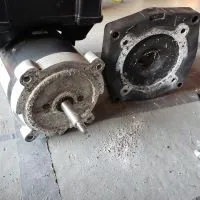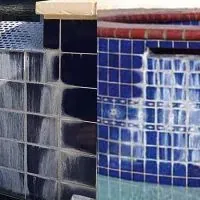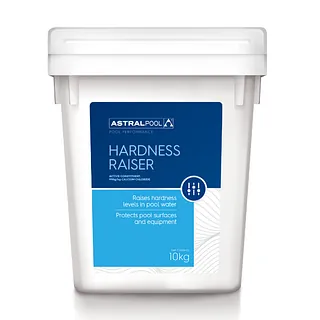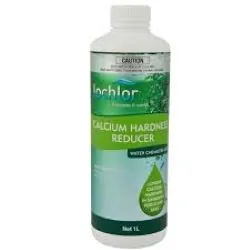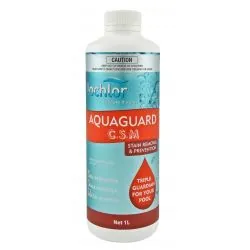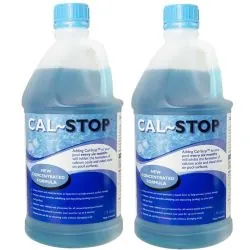Calcium Hardness
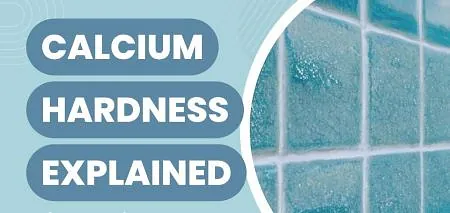
Calcium FAQs
What is calcium chloride?
Calcium chloride goes by chemical formula CaCl₂. It’s bonded, calcium and chlorine.
One calcium atom (Ca) two chlorine atoms (Cl)
What is calcium hardness?
Calcium is always present in your pool. Hardness is the measure of how much calcium (or calcium carbonate) is present in your swimming pool water. Excessive calcium in a pool is typically the result of an imbalance in your pool water, and it can result in white, scaly buildup.
What causes excess calcium in a swimming pool?
In most cases, excess calcium happens when your pool water is not properly balanced. Common culprits are high pH, fluctuating temperatures, and evaporation.
How do I find out the calcium content in my swimming pool water?
Our pool testing kits measure calcium along with other important levels such as chlorine, pH and alkalinity. Reagents for measuring calcium hardness will be discussed later
How do you remove calcium buildup from a swimming pool?
Refer to our page dedicated to scaling identification and treatment, billabongpoolservice.com.au/scale
Is Calcium Hardness level the same for all surfaces?
Short answer is no, but we will expand in the section on chemical parameters.
Calcium Hardness: It’s like the backbone of your pool water. You may know hard water at home likes stubborn mineral deposits on your shower head, in bathtubs or on wet area tiles. Well, pools can have it too. Calcium hardness in pools matters. Here’s the lowdown:
What Is Calcium Hardness?
Calcium hardness refers to the concentration of calcium ions in your pool water. These ions come from various sources: tap water, chemicals. Calcium hardness can be a bit of a troublemaker in a pool. Too low or too High, and issues with the surface of pools and equipment will occur.
The Correct Calcium Hardness Level: It Depends!
A vinyl or fibreglass liner? Aim for a calcium hardness range between, 180 to 220 parts per million (ppm).
A concrete or plaster pool? Aim for calcium hardness range between, 180 to 250 ppm.
A Quartzon pool? Aim for calcium hardness range between, 200 to 300 ppm
Balance, needs not too hard or soft.
The Perils of Low Calcium Hardness:
Metal Corrosion: Calcium isn’t just a mineral; Calcium is a reactive metal. When it meets air, it forms a dark oxide-nitride layer. When hardness is too low, your pool water becomes calcium craving - it leaches calcium from surfaces like concrete, plaster, and grout. Result? , The pool equipment metal bits start rusting, like pumps, heater equipment, ladders, safety rails.
Concrete and Plaster Woes: Low calcium hardness can turn your pool water into a pickpocket. It leaches calcium from your pool’s surfaces, leading to erosion, pitting, and a general grumpiness among the tiles.
Foamy Water: Soft water can cause pool water to foam up.
Fixing Low Calcium Hardness:
To rescue the pool from calcium deficiency, use Calcium Chloride (AKA - Hardness Raiser): Add this to the pool to increase calcium hardness. Dose rates will be discussed in a future module.
The Perils of High Calcium Hardness:
High calcium hardness! Because we’re about to explore the perils of calcium excess or high calcium hardness.
Damage to Your Pool Walls and Equipment:
Scaling Around the Pool Walls and Equipment:
When calcium levels are too high, it starts to affect your pool walls and equipment in the following ways.
Unsightly scale buildup, made of calcium carbonate, and it can start to form right from day one, when a new pool is filled with water. White, crusty deposits on your pool tiles or the edges of your pool? That’s scaling.
Scaling isn’t just an aesthetic issue; it messes with water flow, clogs filters, affects.
Rough Pool Surface:
High calcium levels affect the pool causes an uneven surface. It becomes rough, abrasive, and unpleasant to the touch.
Swimmers may complain, “Hey, this pool feels like fine-grit sandpaper!” in extreme cases may cause skin abrasions.
High pH Level:
Calcium hardness and pH and T.A. are connected. When calcium levels increase, pH with the help of T.A. it influences the balance of the water to become more alkaline. High pH means your water becomes basic. It messes with chlorine effectiveness, irritates eyes, and generally throws pool parties for algae.
Cloudy Water:
You will know from our general aims for water chemistry
PROVIDE WATER THAT IS AESTHETICALLY PLEASING, FREE FROM TASTE AND ODOUR.
PROVIDE WATER THAT IS IN A PASSIVE STATE TO ITS SURROUNDS.
Excess calcium can cause cloudiness. So that is in conflict with the above general aims.
Clogged Filters:
Filters work hand in hand with pool sanitation. But when calcium hardness is very high, calcium scaling particles can reside in the filtration media, causing high filter pressures and effecting sanitation efficiency.
The Ideal level of Calcium hardness:
The quest for the perfectly balanced water. Not too much calcium (which leads to scaling) and not too little (which leads to a calcium scavenger).
Ideal calcium hardness levels range from (*in general) 180 to 250 ppm. It’s like the sweet spot for the pool, where pH and the rest of chemistry, is in balance.
*different surfaces may have slightly different ranges, refer to a future module on chemical parameters.
How to reduce Calcium:
Sequestration: Calcium Reducer, Aquaguard, Stain & Scale Defence, Calstop. Add one of these to the pool water on a regular basis to lower calcium levels.
Dilution: Partially drain and refill your pool with fresh water. Consider it akin to a detoxification process for pools. but take in to consideration that this will also reduce other dilutionable chemical such as salt and cyanuric acid.
Using Alt. Make-Up water: When using water from tanks, bores or dams that have very hard water a program of sequestration will be required along with close monitoring of pH and T.A.
Heavy or extended rainfall can impact the calcium hardness in swimming pools. Rainwater, which is usually very soft and almost devoid of calcium, can dilute the calcium concentration in your pool when it mixes with the pool water. This can result in a decrease in overall calcium hardness.
If the calcium levels in your pool are already low, further dilution may cause the water to become excessively soft, potentially causing corrosion to the pool's surfaces and equipment. On the other hand, if the calcium hardness in your pool is high, rainwater can assist in bringing it down to more optimal levels.
Balance: Regularly test your water and keep it balanced.
Calcium Hardness versus Total Hardness
In swimming pool water chemistry, Calcium Hardness (CH) and Total Hardness (TH) are two important parameters, but they measure slightly different things:
Calcium Hardness (CH): This measures the amount of dissolved calcium in the water. Calcium is a crucial component because it helps maintain the structural integrity of pool surfaces and equipment. If the calcium levels are too low, the water can become corrosive and start leaching calcium from the pool’s plaster, concrete, or metal fittings. On the other hand, if the calcium levels are too high, it can lead to scaling and cloudy water.
Total Hardness (TH): This measures the total amount of dissolved minerals in the water, including both calcium and magnesium. While magnesium is not as significant in pool chemistry as calcium, it is still included in the total hardness measurement. Most test kits measure total hardness, which can sometimes be misleading if you are specifically concerned about calcium levels refer to our module on testing for more information.
In summary, while both parameters are important, Calcium Hardness is more relevant for maintaining the balance and health of your pool water Total Hardness is a relevant parameter for pools using mineral blended salts as precursor for chlorine production. It’s essential to keep the calcium levels within the recommended range to prevent damage to your pool and equipment.

